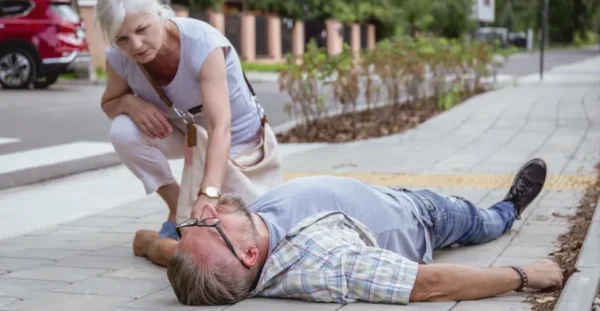Recognising and Responding to Sudden Cardiac Arrest: A Lifesaving Skill for Every Kiwi
When someone suddenly collapses, stops breathing, and becomes unresponsive, recognising sudden cardiac arrest (SCA) and acting fast could be the difference between life and death. SCA is one of the most critical medical emergencies — it often happens without warning, even to those who seem fit and healthy.
Whether you’re at home, on the job, at the marae, or out in public, knowing the signs of cardiac arrest — and what to do — can dramatically increase someone’s chance of survival.
What is sudden cardiac arrest?
Sudden cardiac arrest occurs when the heart’s electrical system malfunctions, causing it to stop beating properly. This can trigger abnormal rhythms, such as ventricular fibrillation, which prevents the heart from pumping enough blood to the brain and other vital organs.
Without oxygen-rich blood, the brain begins to shut down within minutes. Without urgent action, permanent brain damage or death can occur rapidly.
It’s important to understand that SCA is not the same as a heart attack. A heart attack is caused by a blockage in the arteries supplying blood to the heart. SCA, on the other hand, is an electrical failure of the heart — and it often strikes without warning.
Who is at risk?
SCA affects thousands of people across Aotearoa every year. While anyone can experience cardiac arrest, certain people are at greater risk, including older adults, men, and those with existing heart conditions.
Common risk factors include:
- A personal or whānau history of heart problems (e.g., heart attacks, arrhythmias, congenital heart conditions)
- High blood pressure, high cholesterol, obesity, or diabetes
- Smoking and alcohol or drug use
- Low potassium or magnesium levels
- Sleep apnoea
- Chronic kidney disease
- A sedentary lifestyle
Sudden cardiac arrest can affect anyone, anywhere — which is why public awareness, regular health checks, and wider access to CPR and AED training are essential across New Zealand.
What sudden cardiac arrest looks like
The hallmark of sudden cardiac arrest is a sudden collapse. The person will often:
- Drop to the ground without warning
- Become unconscious and unresponsive
- Stop breathing normally
Some people may display seizure-like movements for 10–20 seconds as the brain loses oxygen. Others might gasp irregularly — this is called agonal breathing and should not be mistaken for normal breathing. These gasps may sound like snorting or gurgling — but they are not signs of life.
If you see someone collapse and they’re not responsive or breathing normally, act immediately.
What to do in the first critical moments
Every second counts during a cardiac arrest. Your quick actions could save a life.
Here’s what to do:
1. Call 111 immediately
Dial 111 and ask for Ambulance. Tell them someone has collapsed and isn’t breathing.
2. Start CPR
If the person is unresponsive and not breathing normally, start chest compressions straight away. Push hard and fast in the centre of the chest — around 100–120 compressions per minute (to the beat of “Stayin’ Alive”).
If you’re unsure about mouth-to-mouth, hands-only CPR is still highly effective.
3. Use an AED as soon as possible
Send someone to get the defibrillator (AED) if one is nearby — many are available in shopping centres, sports clubs, schools, airports, and community centres across NZ. Turn the AED on and follow the voice prompts. It will assess the person’s heart rhythm and deliver a shock if needed.
Using an AED within the first few minutes of collapse can significantly increase the chance of survival.
Why CPR, AED and First Aid training matters
Despite the frequency of sudden cardiac arrest, bystander response rates in New Zealand remain low. Fewer than half of people in cardiac arrest receive CPR from a passer-by, and AEDs are only used in a small number of cases.
Yet, these simple steps can more than double the chance of survival.
Getting trained in CPR, AED and First Aid provides you with:
- Hands-on learning using real-life scenarios
- Instructor-led practice with live feedback
- Flexible options, including in-person or online courses
- Confidence and readiness to respond in a crisis
Whether you’re a parent, teacher, coach, office worker, or volunteer — learning these skills means you’re prepared to step up when it matters most.
In a medical emergency, every second matters — so does your training
Sudden cardiac arrest can happen anywhere, to anyone — at school, at home, on the rugby pitch, or at work. It’s fast, silent, and deadly — but with the right training, you could save a life.
By knowing the signs — such as sudden collapse, abnormal gasping, or unresponsiveness — and acting quickly with CPR and an AED, you can give someone the best chance of survival and recovery.
You don’t need to be a paramedic to make a difference. You just need the knowledge, the willingness to act, and the confidence to start.
Keen to get trained?
Already passionate about safety and helping others? Consider becoming a First Aid Instructor — and help build a stronger, more prepared Aotearoa, one course at a time.

